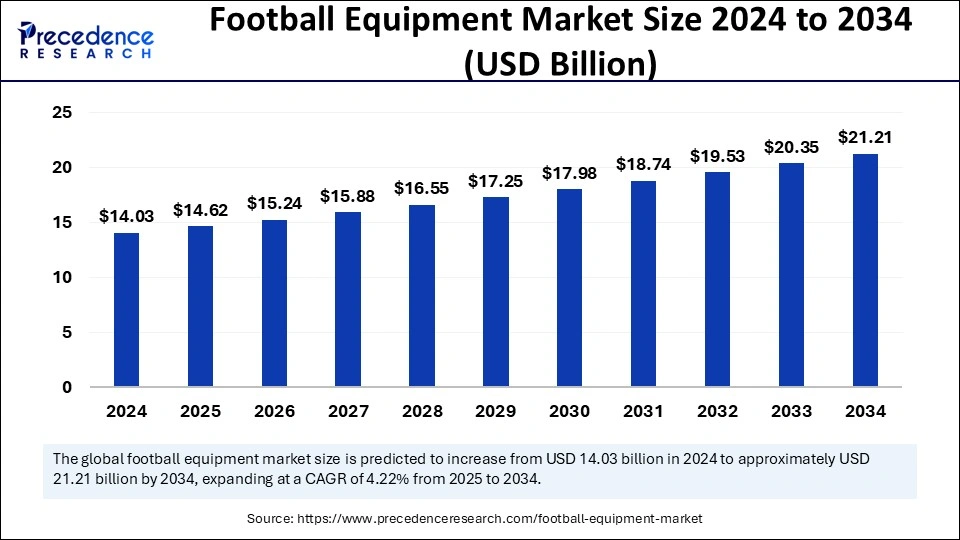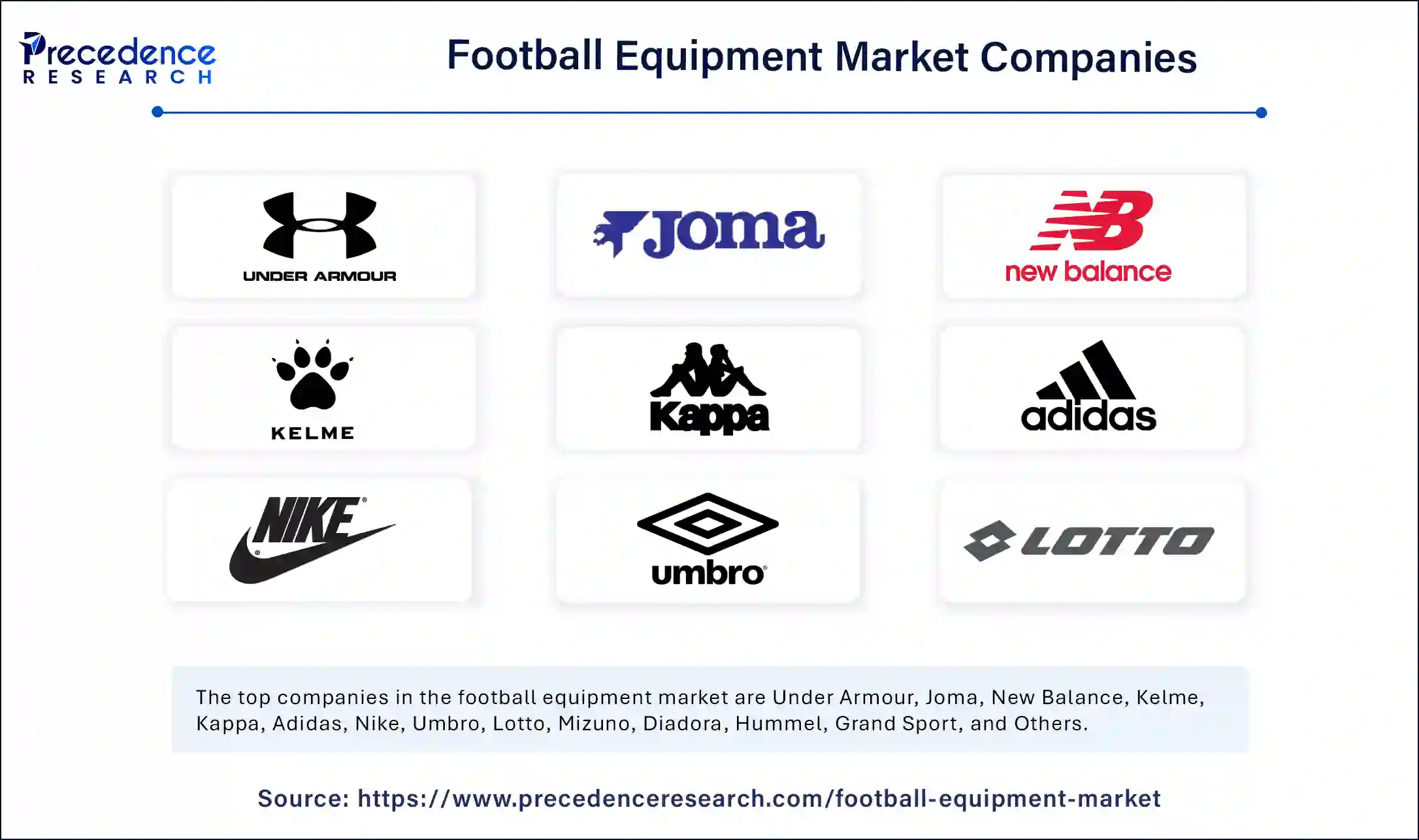Football Equipment Market Expected to Achieve USD 21.21 Billion by 2034
Football Equipment Market Size and Forecast 2025 to 2034
The global football equipment market is forecasted to increase from USD 14.03 billion in 2024 to USD 21.21 billion by 2034, growing at a CAGR of 4.22%.

Football Equipment Market Key Takeaways
-
North America commanded the largest share of 36% in the global market in 2024.
-
Europe is expected to have the fastest growth rate in the upcoming years.
-
The football segment was the top contributor to market share by product type in 2024.
-
Footwear is projected to grow at the highest CAGR between 2025 and 2034 by product type.
-
Leather was the leading material segment by market share in 2024.
-
The synthetic material segment is likely to see substantial growth over the forecast period.
-
Offline channels generated the majority of market share in 2024.
-
The online distribution channel is anticipated to grow at the fastest CAGR from 2025 to 2034.
-
The professional players segment held the largest share by end-user in 2024.
-
The youth players segment is expected to expand significantly during the forecast period.
Impact of AI on the Football Equipment Market
AI is transforming the football equipment market by improving both player performance and product design. AI-driven wearables and sensors help track real-time data on players’ movements, speed, and fatigue, allowing for data-driven decisions to optimize training and prevent injuries. Additionally, AI is enabling the development of personalized football gear, such as customized footwear and protective equipment, based on player preferences and biomechanics, ensuring better comfort and performance.
Moreover, AI is enhancing the training process with smart footballs and virtual coaching assistants that provide real-time feedback to improve skills. In terms of logistics, AI is optimizing inventory management and supply chains, forecasting demand, and ensuring timely availability of products. AI also enhances the consumer experience through personalized recommendations and virtual try-ons, making it easier for players to select the right equipment.
Football Equipment Market Growth Factors
-
Increasing Popularity of Football Globally: Football’s widespread popularity across various regions, particularly in North America, Europe, and emerging markets, has contributed to rising demand for football equipment. This growth is amplified by major tournaments like the FIFA World Cup and regional leagues, which continue to fuel interest in the sport.
-
Technological Advancements in Equipment: Continuous innovations in football equipment, such as the development of lightweight, durable, and performance-enhancing gear, are driving market growth. The integration of AI and data analytics into the design of football gear, such as boots that enhance performance or sensors in balls that track player statistics, is attracting both professionals and amateurs alike.
-
Increasing Participation at All Levels: The growth of grassroots football and youth programs has significantly boosted the demand for football equipment. As participation rates increase across various age groups and skill levels, the need for high-quality, durable gear grows, contributing to the market’s expansion.
-
Rising Investment in Professional Football: Increased investment in professional football leagues, teams, and player development programs globally is another growth factor. This has led to enhanced demand for high-performance football equipment tailored to elite athletes’ needs.
-
E-commerce Growth: The rising popularity of online shopping platforms is fueling the demand for football equipment. E-commerce provides a convenient and accessible way for consumers to purchase football gear, which is especially beneficial for regions with limited access to physical retail stores.
-
Focus on Health and Fitness: With a growing focus on health and fitness, more people are taking up football as a form of exercise, which is driving the demand for football equipment for recreational use. This trend, combined with an increased focus on sports safety and comfort, boosts the market for high-quality football gear.
-
Rising Sponsorships and Brand Collaborations: Collaborations between top football brands, sports teams, and renowned athletes are contributing to the growth of the football equipment market. These partnerships lead to more awareness, innovations, and marketing efforts that drive consumer interest in football products.
Football Equipment Market Overview
The global football equipment market is experiencing significant growth as the sport continues to gain widespread popularity across the globe. The market includes a broad range of products, from footballs, boots, and protective gear to training equipment and accessories. The increasing involvement of both professional and amateur players in football, coupled with growing youth participation, is fueling the demand for high-quality football gear. Additionally, technological innovations in equipment design, such as performance-enhancing materials and the integration of data-tracking technology, are further contributing to market expansion.
Football Equipment Market Scope
| Report Coverage | Details |
| Market Size by 2034 | USD 21.21 Billion |
| Market Size in 2025 | USD 14.62 Billion |
| Market Size in 2024 | USD 14.03 Billion |
| Market Growth Rate from 2025 to 2034 | CAGR of 4.22% |
| Dominating Region | North America |
| Fastest Growing Region | Asia Pacific |
| Base Year | 2024 |
| Forecast Period | 2025 to 2034 |
| Segments Covered | Product Type, Material, Distribution Channel, End-User, and Regions |
| Regions Covered | North America, Europe, Asia-Pacific, Latin America, and Middle East & Africa |
Football Equipment Market Dynamics
Drivers
Several key factors are driving the growth of the football equipment market. The most significant driver is the increasing popularity of football globally, which has sparked a rising demand for football gear, both for professional players and enthusiasts. Major tournaments like the FIFA World Cup and regional leagues continuously fuel interest in the sport. Additionally, the growing emphasis on fitness and health has led to more people participating in football at recreational and professional levels, further increasing the need for quality football equipment. Technological advancements, such as lightweight materials, enhanced durability, and smart features integrated into footwear and balls, have also contributed to market growth.
Opportunities
The football equipment market presents various opportunities for expansion and innovation. One of the key opportunities lies in the rising participation of youth and grassroots football, which drives long-term demand for football gear. The growing number of female players and increased investment in women’s football also presents a new avenue for market growth. Moreover, advancements in online retail and e-commerce platforms offer an excellent opportunity for brands to reach a wider audience, particularly in regions with limited access to physical retail outlets. In addition, the development of smart football equipment, such as performance-monitoring devices and AI-enabled gear, offers substantial growth prospects for manufacturers to meet the evolving needs of players and teams.
Challenges
Despite its growth prospects, the football equipment market faces several challenges. The high cost of some premium equipment, especially for professional players, may limit accessibility for certain consumer groups, particularly in developing regions. Counterfeit products and low-quality alternatives can also harm the market by eroding brand reputation and consumer trust. Moreover, the fluctuating prices of raw materials used in football equipment manufacturing, such as leather and synthetic materials, can impact production costs and pricing strategies. Lastly, the challenge of catering to the diverse preferences and requirements of different market segments, including men, women, and youth players, adds complexity to product development and marketing efforts.
Regional Insights
The football equipment market is geographically diverse, with North America, Europe, and the Asia-Pacific region being the key players. North America is currently the leading market, accounting for a significant share in 2024. The region’s dominance is attributed to the popularity of American football and growing interest in soccer, particularly among the youth. Europe is expected to witness the fastest growth due to the region’s strong football culture, particularly in countries like the UK, Spain, Germany, and France. The Asia-Pacific region, with its rapidly growing middle class and increasing interest in football, is emerging as an important market for football equipment. Countries like China, Japan, and India are seeing a surge in participation at both professional and grassroots levels, driving demand for football gear. Additionally, Latin America is also a growing market, driven by the region’s passion for football and the increasing number of recreational players.
Football Equipment Market Companies

- Under Armour
- Joma
- New Balance
- Kelme
- Kappa
- Adidas
- Nike
- Umbro
- Lotto
- Mizuno
- Diadora
- Hummel
- Grand Sport
- Puma
- Asics
Football Equipment Market Recent Developments
- In July 2023, Adidas launched the X CRAZYFAST, its latest boot featuring “AERO” technology aimed at enhancing speed during play. The new boots were released in three different versions: “P+,” “P1 Laced,” and “P1 Laceless.” Collectively, these models offer players of all skill levels the most advanced speed-oriented technology available.
Segments Covered in the Report
By Product Type
- Football
- Footwear
- Protective Gear
- Training Equipment
- Accessories
By Material
By Distribution Channel
- Online
- Offline
- Sports Stores
- Wholesale
By End-user
- Professional Players
- Amateur Players
- Youth Players
- Coaches
- Clubs
By Region
- North America
- Europe
- Asia Pacific
- Latin America
- Middle East and Africa
Also Read: Single-Use Vape Battery Market
Ready for more? Dive into the full experience on our website@ https://www.precedenceresearch.com/
